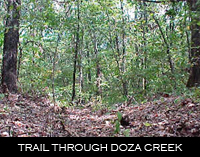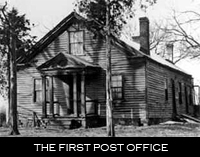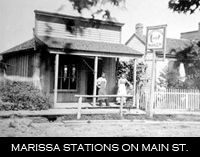Mouse Over The Image To See A Description Or To Stop The Slideshow
 Before 1700 the Marissa area was inhabited by various native American tribes. Among those were Kaskaskias, Peorias, Cahokias, Iroquois and Michiganies but the most prevalent in the immediate area were probably the Tamaroas. It is known that just south of Marissa cemetery on a hill at 321 Doza Creek Road a settlement existed as many artifacts have been recovered over the years. Also there are still the remains of a trail that was used by the tribes as they traveled east and west. Evidence of this can still be scene just north of the dwelling at 132 Doza Creek Rd. The three feet deep trench running through the woods was worn by foot and horse traffic, some pulling two pole skids carrying possessions.
Before 1700 the Marissa area was inhabited by various native American tribes. Among those were Kaskaskias, Peorias, Cahokias, Iroquois and Michiganies but the most prevalent in the immediate area were probably the Tamaroas. It is known that just south of Marissa cemetery on a hill at 321 Doza Creek Road a settlement existed as many artifacts have been recovered over the years. Also there are still the remains of a trail that was used by the tribes as they traveled east and west. Evidence of this can still be scene just north of the dwelling at 132 Doza Creek Rd. The three feet deep trench running through the woods was worn by foot and horse traffic, some pulling two pole skids carrying possessions.
During the early 1700 white man made his first appearance in the region. French hunters and trappers ventured into the area in quest of its plentiful game. One of the first was Elexe Doza and he gave his last name to a creek that lies just south of the village.
The first settlers came to the area around 1805. John Lively had moved his family here from South Carolina and built a log cabin about 2 miles east of Marissa near the Risdon School Road. A second family moved into the area about four years later and they too were followed by others.
The encroachment of the Indian's land had begun and as could be expected conflicts began to surface. Because of the hostilities, small wooden forts were built by the settlers that afforded them a place to retreat when threats of attack loomed. One of these were constructed on Doza Creek about a ¼ mile north of where it is crossed by the Risdon School Road. Crumbling remains of the fort were reportedly still in existence in the early 1960's but were destroyed by strip mining of the area.
A steady stream of settlers continued and in 1818 Illinois was granted statehood and in 1831 the first elementary school opened in the area.
 In 1837 a settler named James Wilson arrived and built a home about two miles south of what is now Marissa. Because the house was located near a trail used by a stagecoach line that carried mail, the stage drivers began leaving letters posted to local residents at his home. From time to time the neighbors would stop by Wilson's home and check for incoming mail as well as leave letters to be sent. Wilson continued to provide this service for several years and in 1846 he was officially appointed the as the areas first postmaster.
In 1837 a settler named James Wilson arrived and built a home about two miles south of what is now Marissa. Because the house was located near a trail used by a stagecoach line that carried mail, the stage drivers began leaving letters posted to local residents at his home. From time to time the neighbors would stop by Wilson's home and check for incoming mail as well as leave letters to be sent. Wilson continued to provide this service for several years and in 1846 he was officially appointed the as the areas first postmaster.
The post office needed a name and Wilson decided to use one that he had found in booked titled "The History of the Jewish Wars." Mareshsh was formerly a city south of Jerusalem that existed in Biblical times. The Greek translation of the name changed the spelling to Marissa. Wilson liked the name and bestowed it on the post office. From that point in time the rural area around it became known as the "Marissa Post Office."
Wilson, a carpenter by trade, built a walnut desk with small partitions to hold the mail of each of the families in the area he served. The desk is still in existence and is displayed at the Marissa Academy building located in the city park.
 By 1854 the Native American population had all but disappeared from the area. A small trading post population had begun to grow about 3 miles north of the post office. A grain mill had been built on the side of the hill to the northwest of our current high school. Nearby were also a store, blacksmith shop and a saloon and several dwellings. Most of these were located abound the 1000 and 1100 block of N. Main St.
By 1854 the Native American population had all but disappeared from the area. A small trading post population had begun to grow about 3 miles north of the post office. A grain mill had been built on the side of the hill to the northwest of our current high school. Nearby were also a store, blacksmith shop and a saloon and several dwellings. Most of these were located abound the 1000 and 1100 block of N. Main St.
The small community continued to grow over the next few years and excitement stirred when plans were made for a railroad to pass through the area. These plans were cut short by the approach of the Civil War. Although Marissa itself was not a site of actual conflict it was an active stop on the Underground Railroad. Several local residents used their homes as safe harbors for slaves as they were smuggled to the safety of the north.
Once the war ended plans for the railroad were renewed and construction began. In 1866 land running through the area was purchased by the Southern Illinois Railroad for the extension of their line. Unfortunately it missed the tiny community and would pass about ¾ miles to the south.
Disappointed but undeterred, Marissa was officially formed as 39 lots were laid out around the area of the existing business. By 1869 the railroad coming from Belleville had reached New Athens and in December of the next year it opened to Marissa.
Seeing opportunity, Mathew and John Hamilton, farmers that owned land on each side of the tracks just south of Marissa, stopped farming, subdivided the land and entered in to merchandising. Because of its location it was called Marissa Station.
 It is difficult for us today to understand the importance of the railroad and it's impact on the areas it transversed. Prior to its arrival the main modes of travel were by foot, horseback or horse and wagon. It was slow and difficult. Poor trails, lack of shelter and dusty rough riding stagecoaches discouraged unnecessary travel. People often lived their entire lives traveling only a few miles from their home.
It is difficult for us today to understand the importance of the railroad and it's impact on the areas it transversed. Prior to its arrival the main modes of travel were by foot, horseback or horse and wagon. It was slow and difficult. Poor trails, lack of shelter and dusty rough riding stagecoaches discouraged unnecessary travel. People often lived their entire lives traveling only a few miles from their home.
But the railroad changed all of this. Suddenly traveling to cities like Belleville and St. Louis became common. As the passenger traffic grew more scheduled trips were added and local residents actually were able to take jobs in the cities and make the daily commute on the train. Traveling salesmen also saw the opportunity and traveled by train to these communities and then rented horses and wagons to use while selling their wares door to door. Also goods that were too expensive or not practical to transport by wagon could be delivered with ease by train. In fact a "kit" to build an entire two story home was purchased from Sears & Roebuck and delivered to Marissa by train. Although it has been moved about 1/4 mile south from its orginal location it can be scene at 219 W. Spring St.
The amount of opportunity just snowballed. Salesmen needed horses and wagons so livery stables sprung up to fill the need. Travelers need places to eat and sleep so restaurants and hotels were built. The people that lived here to provide those services needed services themselves so more stores were established.
In addition to other trade coal mines that were rare before sprung up along the railroad tracks. Easy access to dependable transportation and almost unlimited markets in the metropolitan areas caused a boom in mining. This in turn supplied many new jobs and brought more people to the area -- each needing the support services which lead to more businesses.
Often it is thought that the railroads just laid tracks and ran trains but in fact they built communities. They shaped the very foundation of many towns that exist today even though the rails have lost their luster as "local" carriers.
 In 1867 the post office was moved to Marissa Station (it actually had two other locations around the area and several post masters since it was started in the Wilson home). The population of Marissa at that time was 30 and Marissa Station about 300. As both communities grew the space between them began to dwindled and an interesting problem developed. This problem actually shaped the course of the two communities for the next 90 years.
In 1867 the post office was moved to Marissa Station (it actually had two other locations around the area and several post masters since it was started in the Wilson home). The population of Marissa at that time was 30 and Marissa Station about 300. As both communities grew the space between them began to dwindled and an interesting problem developed. This problem actually shaped the course of the two communities for the next 90 years.
A very vocal percentage of the population of Marissa Station decided that they did not want liquor sold in the community. Because they lacked any authority to close the three operating taverns it was decided to incorporate the community and pass appropriate ordinances. There was a heated debate and the issue of incorporation was brought to a vote three times before passing. Finally on May 26, 1882 the measure was accepted and the area formally known as Marissa Station became the "Village of Marissa."
Since an official city was formed an election was then scheduled for the office of the mayor and trustees. Quickly two parties developed -- not Republican and Democrat but "wet" and "dry." The election was spirited but the "drys" prevailed and alcohol was banned. The three taverns were effectively legislated out of business!
 In 1886 the Marissa Academy was formed to provide secondary education for area youths. For a few years classes were taught in various locations but in 1891 a structure to house the school was built. It still stands in the village park and is the home of the Marissa Historical and Genealogical Society. It is the only structure of it's type and has been added to the National Register of Historical Sites.
In 1886 the Marissa Academy was formed to provide secondary education for area youths. For a few years classes were taught in various locations but in 1891 a structure to house the school was built. It still stands in the village park and is the home of the Marissa Historical and Genealogical Society. It is the only structure of it's type and has been added to the National Register of Historical Sites.
Eleven years after the Village of Marissa was officially formed the area to the north called "Marissa" was incorporated into a city and took the name "Village of Old Marissa." The sale of liquor was never a question there and a thirsty resident of Marissa needed just to step across the city limits line to Old Marissa to satisfy his thirst.
As time passed the two towns expanded until they visibly looked as if they were one community. But for the next 72 years the two villages operated with complete autonomy. There were two mayors, two boards and two sets of ordinances. Residents referred to themselves as either living in "New Town" or "Old Town." The relationship was friendly, yet without question the separation was continued by mutual agreement and pride within each community.
 The turn of the century brought the construction of an electric plant that greatly improved the quality of life. But fire was still a serious problem. A forty man volunteer fire department was formed in 1900 but fire fighting equipment was minimal. In 1902 a devastating fire destroyed two blocks of the business district and threatened the entire community. Serious fires in the business district also occurred again in 1906 and 1911. Although fire fighting equipment was updated the lack of a central water system was the root of the problem. It was not until 1937 that a complete system including fire hydrants was installed and the threat of fire was finally reduced.
The turn of the century brought the construction of an electric plant that greatly improved the quality of life. But fire was still a serious problem. A forty man volunteer fire department was formed in 1900 but fire fighting equipment was minimal. In 1902 a devastating fire destroyed two blocks of the business district and threatened the entire community. Serious fires in the business district also occurred again in 1906 and 1911. Although fire fighting equipment was updated the lack of a central water system was the root of the problem. It was not until 1937 that a complete system including fire hydrants was installed and the threat of fire was finally reduced.
The villages continued to grow over the next 30 years and in the early 1970's a movement began to combine two. It was brought to a vote in September of 1971 and passed 333 to 241. Following the election the two towns merged and became the Village of Marissa.
For quite a few years after the change local residents would still refer to "New Town" or "Old Town" in conversation but by the 1990's it is rarely mentioned. We are now one community of 2200 hardworking citizens with the solid Midwestern values.
And by the way, we are the ONLY city on earth named "Marissa" -- a unique distinction in an ever shrinking world.